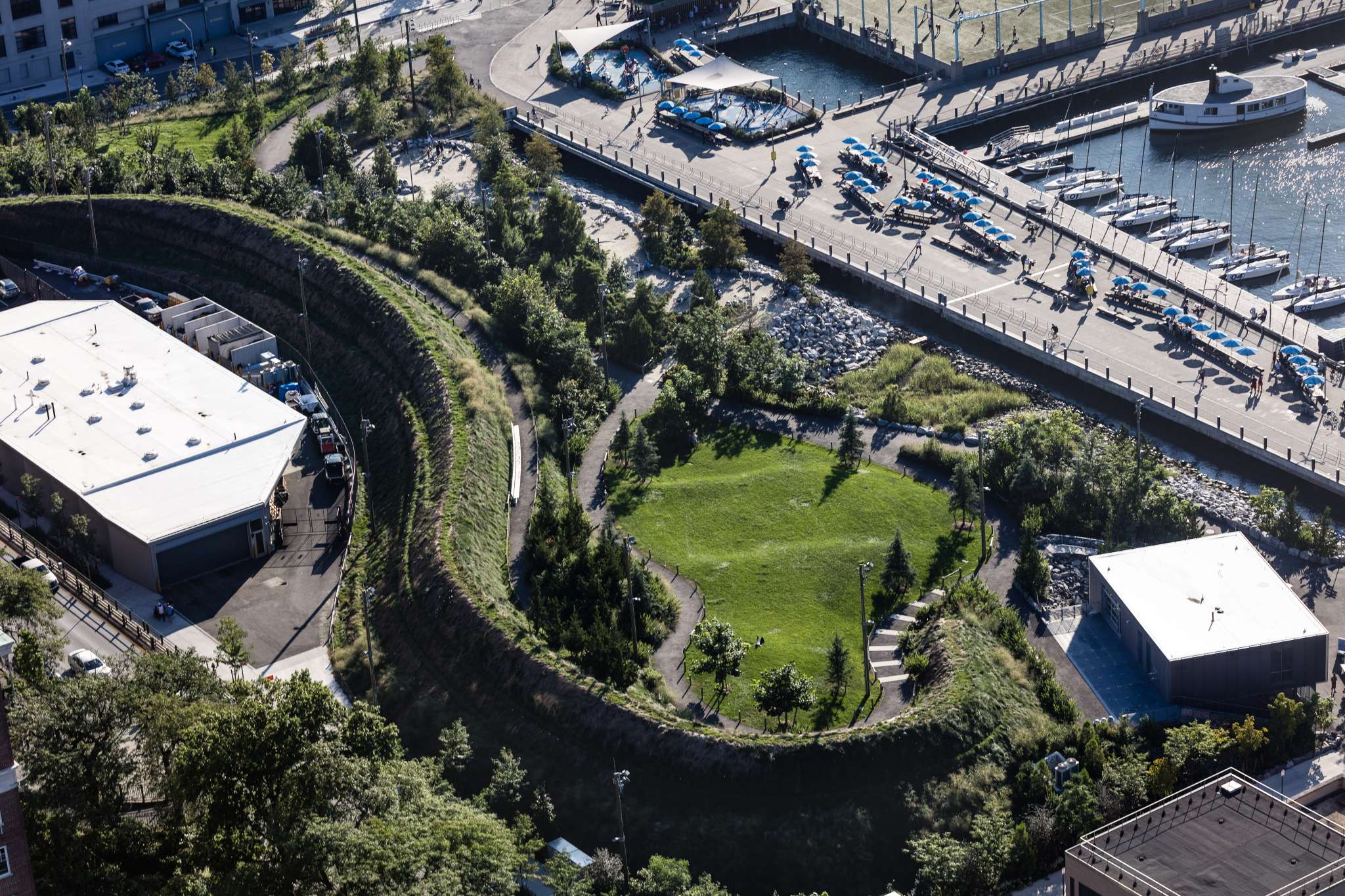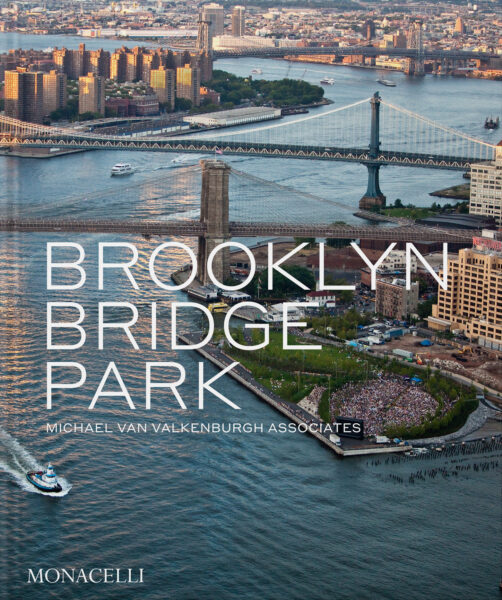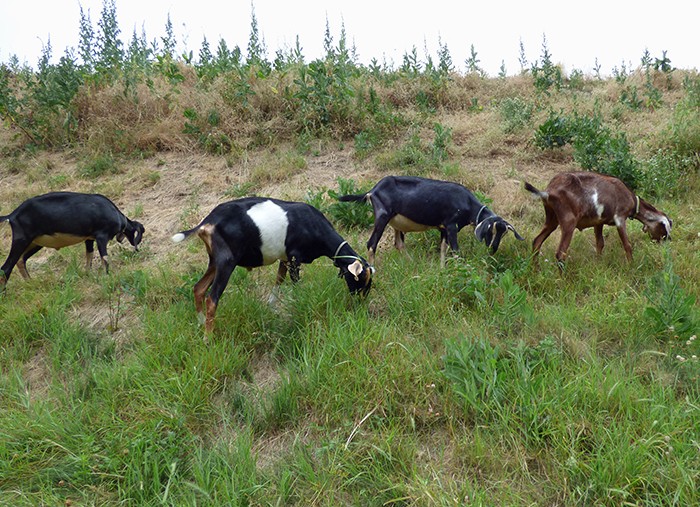
Designer of Brooklyn Bridge Park tells more about the ‘magical berms’

 EDITOR’S NOTE: The grassy berms in Brooklyn Bridge Park are one of the magical details that help make BBP so special. Designed by Michael Van Valkenburgh Associates to serve as “sound attenuation devices” for the BQE traffic noise, they also function as a healthy habitat for birds and bees, literally. As Michael Van Valkenburg is about to appear in a live interview March 21, hosted by the Brooklyn Dining Club, it seemed an opportune moment to ask a few questions ahead of time. Subject: the berms.
EDITOR’S NOTE: The grassy berms in Brooklyn Bridge Park are one of the magical details that help make BBP so special. Designed by Michael Van Valkenburgh Associates to serve as “sound attenuation devices” for the BQE traffic noise, they also function as a healthy habitat for birds and bees, literally. As Michael Van Valkenburg is about to appear in a live interview March 21, hosted by the Brooklyn Dining Club, it seemed an opportune moment to ask a few questions ahead of time. Subject: the berms.
BROOKLYN EAGLE (BE): As beautifully functional as the berms are for sound attenuation, a layman might ask: Would not trees help in sound attenuation?
MICHAEL VAN VALKENBURGH (MVV): As we were developing solutions to block the noise of the BQE, we brought on acoustic engineers at Cerami & Associates to help model our ideas and determine the materials and dimensions that would be most effective. Sound waves pass right through the branches and leaves of trees, unlike solid earth. It is also extremely difficult to support trees on a 45-degree slope.
Don’t miss Michael Van Valkenburgh live, interviewed by journalist and former BBC anchor and correspondent, Laura Trevelyan, March 21 at the Brooklyn Dining Club.
BE: What were some of the soil selection parameters for the berms? For example, is there any clay in the soil? Was a soil search necessary to find the right mixture?
MVV: We worked with our geotechnical engineers and soil scientists to determine the ideal horticultural soil and “bulk fill,” meaning the soil, rock, or aggregate used to reach a required height. In the case of the berms, only the first 24 inches consist of planting soil—which includes some percentage of clay, like most soils in the park, and was optimized for the plants we had in mind. Because the slope is so extreme, the earth is reinforced with layers of textile grids that keep the soil in place.

Image courtesy of Monacelli
BE: Same question for the grass. Also, it was beyond charming to see happy animals grazing on the grass, acting as natural ‘lawnmowers.’ But a casual observer has not seen the animals recently; how is the grass (and the park at large) maintained?
MVV: The plants were also selected to increase stability and limit erosion. We began with warm-season grasses and native forbs on the first berm and later turned to a cold-season mix of fescues, bluegrass, and autumn bentgrass.
The berms and their plantings, like the rest of the park, are maintained by the Brooklyn Bridge Park Corporation, which is a non-profit controlled by the City of New York. The horticulture staff at the Brooklyn Bridge Park Corporation, led by Rashid Poulson, are an amazing crew that are individually tasked with caring for their own portions of the landscape. The maintenance budget is supplied by the park’s revenue-generating commercial developments, such as the 1 Hotel, which ensures that the landscape will be properly cared for in perpetuity.

BE: In the international sweep of the design impact of Van Valkenburgh and Associates, are there other notable parks that have used the berm concept?
MVV: Berms like those at Brooklyn Bridge Park have not been replicated anywhere else in our work, but many of our projects use constructed topography to create more comfortable environments for people: Gathering Place in Tulsa, Hudson River Park and Teardrop Park in Manhattan, Gateway Arch National Park in St. Louis, among others.
Don’t miss Michael Van Valkenburgh live, interviewed by journalist and former BBC anchor and correspondent, Laura Trevelyan, March 21 at the Brooklyn Dining Club.
BE: In so many miles of natural waterfront exposure, most city people think of either beaches or tidal marshes. Rivers and currents offer a different challenge to waterfront parks and development. Can you speak of other projects involving rivers?… Indeed, how about raging rivers?
MVV: Many of our projects include riverfronts or sites impacted by rivers: our first major park commission was Mill Race Park in Columbus, Indiana, which sat in the floodplain of two rivers and faced as much as 10 feet of flooding. We built Allegheny Riverfront Park in Pittsburgh not long after. More than 20 years later, we are nearing the completion of the Port Lands Flood Protection project in Toronto, which involved the reconstruction of the mouth of the Don River in Toronto to remove several hundred acres of land from the river’s floodplain, enabling significant development and the creation of more than 100 acres of parks and wildlife habitats on Lake Ontario. We are also wrapping up the construction of a new riverfront at Gathering Place on the Arkansas River, which includes a water recreation area and a bridge that spans the river, opening this summer.

Photo: Robert Adam Mayer
Leave a Comment
Related Articles


Bay Ridge leads Brooklyn in showing how a NORC should work best

Premium Content
Here’s why Bay Ridge, a ‘Naturally Occurring Retirement Community’ (NORC), takes good care of older adults

Remembering Haley Daquara
Liberty Kiwanis, Greenhouse Café
hold fundraiser to celebrate a life
Leave a Comment

Brooklyn Heights
View MoreRead the Brooklyn Height's Press and Cobble Hill News. Find out more about Brooklyn Height's History here.
The Brooklyn Daily Eagle and brooklyneagle.com cover Brooklyn 24/7 online and five days a week in print with the motto, “All Brooklyn All the Time.” With a history dating back to 1841, the Eagle is New York City’s only daily devoted exclusively to Brooklyn.
© 2024 Everything Brooklyn Media
https://brooklyneagle.com/articles/2024/03/12/designer-of-brooklyn-bridge-park-on-the-magical-berms/
